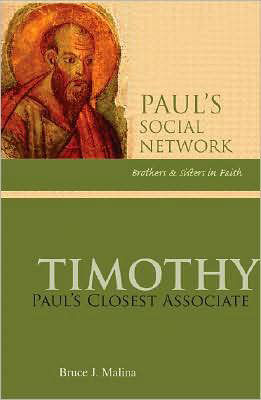
|
Posted January 26, 2008
Book: Paul’s Social Network: Timothy, Paul’s Closest Associate Author: Bruce J. Malina Liturgical Press. Collegeville, MN. 2007. Pp. 156 An Excerpt from the Jacket:
An Excerpt from the Book: This Timothy with no last name lived at a time when most people were known by one name only. . . . The one-named Timothy had no further, attested name. Yet he was known in the first Jesus-movement groups from his association with another one-named person, Saul (a Semitic name; Saul also had a Greek name, Paul, perhaps because in Greek saulos meant “waddler,” one who walked like a prostitute”). This Saul/Paul is well known in modern Christian circles as Paul the Apostle or Paul the Apostle to the Gentiles. And it is through his association with this Paul that the Timothy who forms the subject of this book has become a rather well-known biblical name. (Think of all the “Tims” you know. Most likely they were named after this Timothy.) This book presents some dimensions of the story of Timothy, associate of Paul the Apostle. Paul is famous in Christian tradition for his letters read in church nearly every Sunday. Church-goers are used to hearing about the letter of St. Paul to the Thessalonians (one of two) to the Corinthians (both of these), or to the Galatians, or to the Philipppians, or to Philemon, or to the Romans. Historically minded scholars have determined that these seven letters trace back authentically to Paul. There are other letters traditionally ascribed to Paul (the letter to the Colossians, 2 Thessalonians, Ephesians, 1 Timothy, 2 Timothy, Titus, and even Hebrews), making fourteen in all. But these other letters come from a period after Paul, from people in the third and fourth generation of Christ-believers belonging to groups founded by Paul and his associates. These groups are usually called “churches” (a translation of the Greek word ekklesia, meaning “a gathering of people summoned or called together”). Since the word “church” is a very “churchy” word today and might lead the reader to think of buildings and groups of people referred to nowadays as “church”, in this book these early gatherings of Christ-believers will be call “Jesus groups.” Table of Contents: Who is Timothy? 1. Timothy: the collective person 2. The Jesus tradition: where does Timothy fit in? 3. Timothy as assistant to Paul: what was Paul up to? 4. Specifics about Timothy: Paul’s cowriter and coworker 5. The Timothy tradition begins; third generation recollections 6. The second letter of Paul and Timothy to the Thessalonians: about forgery 7. Final traditions about Timothy in the New Testament |
|
